Western Front (World War II)
| ||||||||||||||||||||||||||||||||
The Western Front of the European theatre of World War II encompassed Denmark, Norway, Luxembourg, Belgium, the Netherlands, the United Kingdom, France, Italy, and Germany.[14] World War II military engagements in Southern Europe and elsewhere are generally considered under separate headings. The Western Front was marked by two phases of large-scale combat operations. The first phase saw the capitulation of the Netherlands, Belgium, and France during May and June 1940 after their defeat in the Low Countries and the northern half of France, and continued into an air war between Germany and Britain that climaxed with the Battle of Britain. The second phase consisted of large-scale ground combat, which began in June 1944 with the Allied landings in Normandy and continued until the defeat of Germany in May 1945.
1939–40: Axis victories
Phoney War
The Phoney War was an early phase of World War II marked by a few military operations in Continental Europe in the months following the German invasion of Poland and preceding the Battle of France. Although the great powers of Europe had declared war on one another, neither side had yet committed to launching a significant attack, and there was relatively little fighting on the ground. This was also the period in which The United Kingdom and France did not supply significant aid to Poland, despite their pledged alliance.
While most of the German Army was fighting against Poland, a much smaller German force manned the Siegfried Line, their fortified defensive line along the French border. At the Maginot Line on the other side of the border, French troops stood facing them, whilst the British Expeditionary Force and other elements of the French Army created a defensive line along the Belgian border. There were only some local, minor skirmishes. The British Royal Air Force dropped propaganda leaflets on Germany and the first Canadian troops stepped ashore in Britain, while Western Europe was in a strange calm for seven months.
In their hurry to re-arm, Britain and France had both begun to buy large numbers of weapons from manufacturers in the United States at the outbreak of hostilities, supplementing their own production. The non-belligerent United States, contributed to the Western Allies by discounted sales of military equipment and supplies. German efforts to interdict the Allies' trans-Atlantic trade at sea ignited the Battle of the Atlantic.
Scandinavia
While the Western Front remained quiet in April 1940, the fighting between the Allies and the Germans began in earnest with the Norwegian Campaign when the Germans launched Operation Weserübung, the German invasion of Denmark and Norway. In doing so, the Germans beat the Allies to the punch; the Allies had been planning an amphibious landing in which they could begin to surround Germany, cutting off her supply of raw materials from Sweden. However, when the Allies made a counter-landing in Norway following the German invasion, the Germans repulsed them and defeated the Norwegian armed forces, driving the latter into exile. The Kriegsmarine, nonetheless, suffered very heavy losses during the two-months of fighting required to seize all of mainland Norway.
Battles for Luxembourg, the Netherlands, Belgium and France
In May 1940, the Germans launched the Battle of France. The Western Allies (primarily the French, Belgian and British land forces) soon collapsed under the onslaught of the so-called "blitzkrieg" strategy. The majority of the British and elements of the French forces escaped at Dunkirk. With the fighting ended, the Germans began to consider ways of resolving the question of how to deal with Britain. If the British refused to agree to a peace treaty, one option was to invade. However, Nazi Germany's Kriegsmarine, had suffered serious losses in Norway, and in order to even consider an amphibious landing, Germany's Air Force (the Luftwaffe) had to first gain air superiority or air supremacy.
1941–44: Interlude
With the Luftwaffe unable to defeat the RAF in the Battle of Britain, the invasion of Great Britain could no longer be thought of as an option. While the majority of the German army was mustered for the invasion of the Soviet Union, construction began on the Atlantic Wall – a series of defensive fortifications along the French coast of the English Channel. These were built in anticipation of an Allied invasion of France.
Because of the massive logistical obstacles a cross-channel invasion would face, Allied high command decided to conduct a practice attack against the French coast. On 19 August 1942, the Allies began the Dieppe Raid, an attack on Dieppe, France. Most of the troops were Canadian, with some British contingents and a small American and Free French presence along with British and Polish naval support. The raid was a disaster, almost two-thirds of the attacking force became casualties. However, much was learned as a result of the operation – these lessons would be put to good use in the subsequent invasion.
For almost two years, there was no land-fighting on the Western Front with the exception of commando raids and the guerrilla actions of the resistance aided by the Special Operations Executive (SOE) and Office of Strategic Services (OSS). However, in the meantime, the Allies took the war to Germany, with a strategic bombing campaign the US Eighth Air Force bombing Germany by day and RAF Bomber Command bombing by night.
Two early British raids for which battle honours were awarded were Operations Collar in Boulogne (11 June 1940) and Ambassador in Guernsey (14–15 July 1940). The raids for which the British awarded the "North-West Europe Campaign of 1942" battle honour were: Operation Biting - Bruneval (27–28 February 1942), St Nazaire (27–28 March 1942), Operation Myrmidon - Bayonne (5 April 1942), Operation Abercrombie - Hardelot (21–22 April 1942), Dieppe (19 August 1942) and Operation - Frankton - Gironde (7–12 December 1942).[15][16]
A raid on Sark on the night of 3/4 October 1942 is notable because a few days after the incursion the Germans issued a propaganda communiqué implying at least one prisoner had escaped and two were shot while resisting having their hands tied. This instance of tying prisoner's hands contributed to Hitler's decision to issue his Commando Order instructing that all captured Commandos or Commando-type personnel were to be executed as a matter of procedure.
By the summer of 1944, when expectation of an Allied invasion was freely admitted by German commanders, the disposition of troops facing it came under the command of OB West (HQ in Paris). In turn it commanded three groups: the Wehrmacht Netherlands Command (Wehrmachtbefehlshaber#Niederlande) or WBN, covering the Dutch and Belgian coasts and Army Group B, covering the coast of northern France with the German 15th Army (HQ in Tourcoing), in the area north of the Seine; the 7th Army, (HQ in Le Mans), between the Seine and the Loire defending the English Channel and the Atlantic coast, and Army Group G with responsibility for the Bay of Biscay coast and Vichy France, with its 1st Army, (HQ in Bordeaux), responsible for the Atlantic coast between the Loire and the Spanish border and the 19th Army, (HQ in Avignon), responsible for the Mediterranean coast.
It was not possible to predict where the Allies might choose to launch their invasion. The chance of an amphibious landing necessitated the substantial dispersal of the German mobile reserves, which contained the majority of their panzer troops. Each army group was allocated its mobile reserves. Army Group B had the 2nd Panzer Division in northern France, 116th Panzer Division in the Paris area, and the 21st Panzer Division in Normandy. Army Group G, considering the possibility of an invasion on the Atlantic coast, had dispersed its mobile reserves, locating the 11th Panzer Division in Gironde, the 2nd SS Panzer Division Das Reich refitting around the southern French town of Montauban, and the 9th Panzer Division stationed in the Rhone delta area.
The OKW retained a substantial reserve of such mobile divisions also, but these were dispersed over a large area: the 1st SS Panzer Division Leibstandarte SS Adolf Hitler was still forming and training in the Netherlands, the 12th SS Panzer Division Hitlerjugend and the Panzer-Lehr Division were located in the Paris-Orleans area, since the Normandy coastal defence sectors or (Küstenverteitigungsabschnitte - KVA) were considered the most likely areas for an invasion. The 17th SS Panzergrenadier Division Götz von Berlichingen was located just south of the Loire in the vicinity of Tours.
1944–45: The Second Front
Normandy
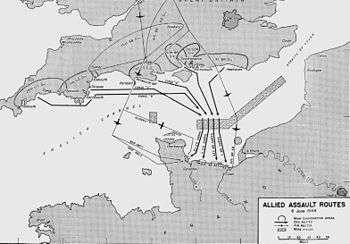
On 6 June 1944, the Allies began Operation Overlord (also known as "D-Day") – the long-awaited liberation of France. The deception plans, Operations Fortitude and Bodyguard, had the Germans convinced that the invasion would occur in the Pas-de-Calais, while the real target was Normandy. Following two months of slow fighting in hedgerow country, Operation Cobra' allowed the Americans to break out at the western end of the lodgement. Soon after, the Allies were racing across France. They encircled around 200,000 Germans in the Falaise Pocket. As had so often happened on the Eastern Front Hitler refused to allow a strategic withdrawal until it was too late. Approximately 150,000 Germans were able to escape from the Falaise pocket, but they left behind most of their irreplaceable equipment and 50,000 Germans were killed or taken prisoner.
The Allies had been arguing about whether to advance on a broad-front or a narrow-front from before D-Day.[17] If the British had broken out of the Normandy bridgehead (or beachhead) around Caen when they launched Operation Goodwood and pushed along the coast, facts on the ground might have turned the argument in favour of a narrow front. However, as the breakout took place during Operation Cobra at the western end of the bridge-head, the 21st Army Group that included the British and Canadian forces swung east and headed for Belgium, the Netherlands and Northern Germany, while the U.S. Twelfth Army Group advanced to their south via eastern France, Luxembourg and the Ruhr Area, rapidly fanning out into a broad front. As this was the strategy favoured by the Supreme Allied Commander, General Dwight D. Eisenhower, and most of the rest of the American high command, it became the strategy which was adopted.
Liberation of France
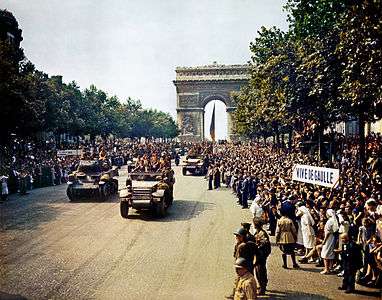
On 15 August the Allies launched Operation Dragoon – the invasion of Southern France between Toulon and Cannes. The US Seventh Army and the French First Army, making up the US 6th Army Group, rapidly consolidated this beachhead and liberated southern France in two weeks; they then moved north up the Rhone valley. Their advance only slowed down as they encountered regrouped and entrenched German troops in the Vosges Mountains.
The Germans in France were now faced by three powerful Allied army groups: in the north the British 21st Army Group commanded by Field Marshal Sir Bernard Montgomery, in the center the American 12th Army Group, commanded by General Omar Bradley and to the south the US 6th Army Group commanded by Lieutenant General Jacob L. Devers. By mid-September, the 6th Army Group, advancing from the south, came into contact with Bradley's formations advancing from the west and overall control of Devers' force passed from AFHQ in the Mediterranean so that all three army groups came under Eisenhower's central command at SHAEF (Supreme Headquarters, Allied Expeditionary Forces).
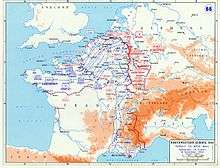
Under the onslaught in both the north and south of France, the German Army fell back. On 19 August, the French Resistance (FFI) organised a general uprising and the liberation of Paris took place on 25 August when general Dietrich von Choltitz accepted the French ultimatum and surrendered to general Philippe Leclerc de Hauteclocque, commander of the Free French 2nd Armored Division, ignoring orders from Hitler that Paris should be held to the last and destroyed.
The liberation of northern France and the Benelux countries was of special significance for the inhabitants of London and the southeast of England, because it denied the Germans launch sites for their mobile V-1 and V-2 Vergeltungswaffen (reprisal weapons).
As the Allies advanced across France, their supply lines stretched to breaking point. The Red Ball Express, the Allied trucking effort, was simply unable to transport enough supplies from the port facilities in Normandy all the way to the front line, which by September, was close to the German border.
Major German units in the French southwest that had not been committed in Normandy withdrew, either eastwards towards Alsace (sometimes directly across the US 6th Army's advance) or into the ports with the intention of denying them to the Allies. These latter groups were not thought worth much effort and were left "to rot", with the exception of Bordeaux, which was liberated in May 1945 by French forces under General Edgard de Larminat (Operation Venerable).[18]
Allied advance from Paris to the Rhine
Fighting on the Western front seemed to stabilize, and the Allied advance stalled in front of the Siegfried Line (Westwall) and the southern reaches of the Rhine. Starting in early September, the Americans began slow and bloody fighting through the Hurtgen Forest ("Passchendaele with tree bursts"—Hemingway) to breach the Line.
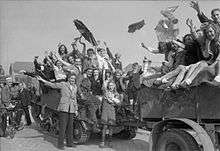
The port of Antwerp was liberated on 4 September by the British 11th Armoured Division. However, it lay at the end of the long Scheldt Estuary, and so it could not be used until its approaches were clear of heavily fortified German positions. The Breskens pocket on the southern bank of the Scheldt was cleared with heavy casualties by Canadian and Polish forces in Operation Switchback, during the Battle of the Scheldt. This was followed by a tedious campaign to clear a peninsula dominating the estuary, and finally, the amphibious assault on Walcheren Island in November. The campaign to clear the Scheldt Estuary was a decisive victory for the First Canadian Army and the rest of the Allies, as it allowed a greatly improved delivery of supplies directly from Antwerp, which was far closer to the front than the Normandy beaches.
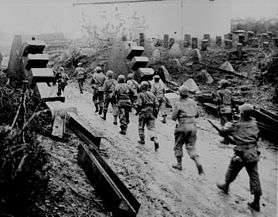
In October the Americans decided that they could not just invest Aachen and let it fall in a slow siege, because it threatened the flanks of the U.S. Ninth Army. As it was the first major German city to face capture, Hitler ordered that the city be held at all costs. In the resulting battle, the city was taken, at a cost of 5,000 casualties on both sides, with an additional 5,600 German prisoners.
South of the Ardennes, American forces fought from September until mid-December to push the Germans out of Lorraine and from behind the Siegfried Line. The crossing of the Moselle River and the capture of the fortress of Metz proved difficult for the American troops in the face of German reinforcements, supply shortages, and unfavorable weather. During September and October, the Allied 6th Army Group (U.S. Seventh Army and French First Army) fought a difficult campaign through the Vosges Mountains that was marked by dogged German resistance and slow advances. In November, however, the German front snapped under the pressure, resulting in sudden Allied advances that liberated Belfort, Mulhouse, and Strasbourg, and placed Allied forces along the Rhine River. The Germans managed to hold a large bridgehead (the Colmar Pocket), on the western bank of the Rhine and centered around the city of Colmar. On 16 November the Allies started a large scale autumn offensive called Operation Queen. With its main thrust again through the Hürtgen Forest, the offensive drove the Allies to the Rur River, but failed in its core objectives to capture the Rur dams and pave the way towards the Rhine. The Allied operations were then succeeded by the German Ardennes offensive.
Operation Market Garden
-_17_-_25_September_1944_EA37782.jpg)
Field Marshal Bernard Montgomery, commanding the Anglo-Canadian 21st Army Group, persuaded the Allied High Command to launch a bold attack, Operation Market Garden, which he hoped would get the Allies across the Rhine and create the narrow-front he favoured. Airborne troops would fly in from the United Kingdom and take bridges over the main rivers of the German-occupied Netherlands in three main cities; Eindhoven, Nijmegen, and Arnhem. The British XXX Corps would punch through the German lines along the Maas-Schelde Kanal and link up with the airborne troops of the U.S. 101st Airborne Division in Eindhoven, the U.S. 82nd Airborne Division at Nijmegen and the British 1st Airborne Division at Arnhem. If all went well XXX Corps would advance into Germany without any remaining major obstacles. XXX Corps was able to advance beyond six of the seven airborne-held bridges, but was unable to link up with the troops near the bridge over the Rhine at Arnhem. The result was the near-destruction of the British 1st Airborne Division during the Battle of Arnhem, which had suffered almost 8,000 casualties. The offensive ended with Arnhem remaining in German hands and the Allies holding an extended salient from the Belgian border to the area between Nijmegen and Arnhem.
Winter counter-offensives

The Germans had been preparing a massive counter-attack in the West since the Allied breakout from Normandy. The plan called Wacht am Rhein ("Watch on the Rhine") was to attack through the Ardennes and swing North to Antwerp, splitting the American and British armies. The attack started on 16 December in what became known as the Battle of the Bulge. Defending the Ardennes were troops of the US First Army. Initial successes in bad weather, which gave them cover from the Allied air forces, resulted in a German penetration of over 80 km (50 mi) to within less than 16 km (10 mi) of the Meuse. Having been taken by surprise, the Allies regrouped and the Germans were stopped by a combined air and land counter-attack which eventually pushed them back to their starting points by 25 January 1945.
The Germans launched a second, smaller offensive (Nordwind) into Alsace on New Year's Day, 1945. Aiming to recapture Strasbourg, the Germans attacked the 6th Army Group at multiple points. Because the Allied lines had become severely stretched in response to the crisis in the Ardennes, holding and throwing back the Nordwind offensive was a costly affair that lasted almost four weeks. The culmination of Allied counter-attacks restored the front line to the area of the German border and collapsed the Colmar Pocket.
Invasion of Germany
In January 1945 the German bridgehead over the river Roer between Heinsberg and Roermond was cleared during Operation Blackcock, followed by the pincer movement of the First Canadian Army in Operation Veritable advancing from the Nijmegen area of the Netherlands and the US Ninth Army crossing the Rur (Roer) in Operation Grenade was planned to start on 8 February 1945, but it was delayed by two weeks when the Germans flooded the river valley by destroying the dam gates upstream. Field Marshal Gerd von Rundstedt requested permission to withdraw east behind the Rhine, arguing that further resistance would only delay the inevitable, but was ordered by Hitler to fight where his forces stood.
By the time the water had subsided and the US Ninth Army was able to cross the Roer on 23 February, other Allied forces were also close to the Rhine's west bank. Von Rundstedt's divisions which had remained on the west bank, were cut to pieces in the 'battle of the Rhineland', - 280,000 men were taken prisoner. With a large number of men captured, the stubborn German resistance during the Allied campaign to reach the Rhine in February and March 1945 had been costly. Total losses reached an estimated 400,000 men.[19]
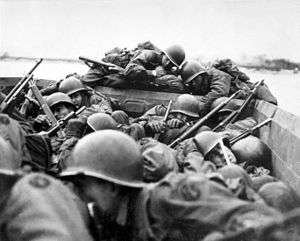
- The crossing of the Rhine was achieved at four points: One was an opportunity taken by US forces when the Germans failed to blow up the Ludendorff bridge at Remagen, one crossing was a hasty assault, and two crossings were planned. Bradley and his subordinates quickly exploited the Remagen crossing made on 7 March and expanded the bridgehead into a full scale crossing.
- Bradley told General Patton whose U.S. Third Army had been fighting through the Palatinate, to "take the Rhine on the run".[20] The Third Army did just that on the night of 22 March, crossing the river with a hasty assault south of Mainz at Oppenheim.
- In the North Operation Plunder was the name given to the assault crossing of the Rhine at Rees and Wesel by the British 21st Army Group on the night of 23 March. It included the largest airborne operation in history, which was codenamed Operation Varsity. At the point the British crossed the river, it is twice as wide, with a far higher volume of water, than the points where the Americans crossed and Montgomery decided it could only be crossed with a carefully planned operation.
- In the Allied 6th Army Group area, the US Seventh Army assaulted across the Rhine in the area between Mannheim and Worms on 26 March.[21] A fifth crossing on a much smaller scale was later achieved by the French First Army at Speyer.[22]

Once the Allies had crossed the Rhine, the British fanned out northeast towards Hamburg crossing the river Elbe and on towards Denmark and the Baltic. British forces captured Bremen on 26 April after a week of combat.[23] British and Canadian paratroopers reached the Baltic city of Wismar just ahead of Soviet forces on 2 May. The US Ninth Army, which had remained under British command since the battle of the Bulge, went south as the northern pincer of the Ruhr encirclement as well as pushing elements east. XIX Corps of the Ninth Army captured Magdeburg on 18 April and the US XIII Corps to the north occupied Stendal.[24]
The US 12th Army Group fanned out, the First Army went north as the southern pincer of the Ruhr encirclement. On 4 April the encirclement was completed and the Ninth Army reverted to the command of Bradley's 12th Army Group. The German Army Group B commanded by Field Marshal Walther Model was trapped in the Ruhr Pocket and 300,000 soldiers became POWs. The Ninth and First American armies then turned east and pushed to the Elbe river by mid-April. During the push east, the cities of Frankfurt am Main, Kassel, Magdeburg, Halle and Leipzig were strongly defended by ad hoc German garrisons made up of regular troops, Flak units, Volkssturm and armed Nazi Party auxiliaries. Generals Eisenhower and Bradley concluded that pushing beyond the Elbe made no sense since eastern Germany was destined in any case to be occupied by the Red Army. The First and Ninth Armies stopped along the Elbe and Mulde rivers, making contact with Soviet forces near the Elbe in late April. The US Third Army had fanned out to the east into western Czechoslovakia and southeast into eastern Bavaria and northern Austria. By V-E Day, the US 12th Army Group was a force of four armies (First, Third, Ninth and Fifteenth) that numbered over 1.3 million men.[25]
End of the Third Reich
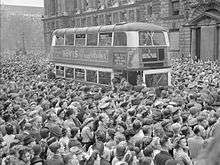
The US 6th Army Group fanned out to the southwest, passing to the east of Switzerland through Bavaria and into Austria and northern Italy. The Black Forest and Baden were overrun by the French First Army. Determined stands were made in April by German forces at Heilbronn, Nuremberg, and Munich but were overcome after several days. Elements of the US 3rd Infantry Division were the first Allied troops to arrive at Berchtesgaden, which they secured, while the French 2nd Armoured Division seized the Berghof (Hitler's Alpine residence) on 4 May 1945. German Army Group G surrendered to US forces at Haar, in Bavaria, on 5 May. Field Marshal Montgomery took the German military surrender of all German forces in The Netherlands, northwest Germany and Denmark on Lüneburg Heath, an area between the cities of Hamburg, Hanover and Bremen, on 4 May 1945. As the operational commander of some of these forces was Grand Admiral Karl Dönitz, the new Reichspräsident (head of state) of the Third Reich this signaled that the European war was over.
On 7 May at his headquarters in Rheims, Eisenhower took the unconditional surrender of all German forces to the western Allies and the Soviet Union,[26] from the German Chief-of-Staff, General Alfred Jodl, who signed the first general instrument of surrender at 0241 hours. General Franz Böhme announced the unconditional surrender of German troops in Norway. Operations ceased at 2301 hours Central European time (CET) on 8 May. On that same day Field Marshal Wilhelm Keitel, as head of OKW and Jodl's superior, was brought to Marshal Georgy K. Zhukov in Karlshorst and signed another instrument of surrender that was essentially identical to that signed in Rheims with two minor additions requested by the Soviets.[27]
See also
Notes
- Footnotes
- ↑ Vichy officially pursued a policy of armed neutrality and conducted military actions against armed incursions from both Axis and Allied belligerents. The cease fire and pledging of allegiance to the Allies of the Vichy troops in French North Africa during operation Torch convinced the Axis that Vichy could no longer be trusted to continue this policy, so they invaded and occupied the French rump state in November 1942.
- ↑ Ellis provides no figure for Danish casualties, he places Norwegian losses at 2,000 killed or missing with no information provided on those wounded or captured. Dutch casualties are placed at 2,890 killed or missing, 6,900 wounded, with no information provided on those captured. Belgian casualties are placed at 7,500 killed or missing, 15,850 wounded, and 200,000 captured. French casualties amounted to 120,000 killed or missing, 250,000 wounded, and 1,450,000 taken prison. British losses totalled to 11,010 killed or missing, 14,070 wounded (only those who were evacuated have been counted), and 41,340 taken prisoner.[3] Losses in 1940, according to Ellis' information, thus amount to 2,121,560.
- ↑ 360,000 dead or wounded, and 1,900,000 captured[4]
- ↑ Ellis's numbers:American: 109,820 killed or missing, 356,660 wounded, and 56,630 captured; British: 30,280 killed or missing, 96,670 wounded, 14,700 captured; Canadian: 10,740 killed or missing, 30,910 wounded, 2,250 captured; French: 12,590 killed or missing, 49,510 wounded, 4,730 captured; Pole: 1,160 killed or missing, 3,840 wounded, 370 captured.[6]
Thus according to Ellis' information, the Western Allies incurred 783,860 casualties.
US Army/Air Forces breakdown: According to a post-war US Army study using war records, the army and army air forces of the United States suffered 586,628 casualties in western Europe, including 116,991 killed in action and 381,350 wounded, of whom 16,264 later died of their wounds.[7] Total US casualties come to 133,255 killed, 365,086 wounded, 73,759 captured, and 14,528 missing, two thousand of whom were later declared dead. - ↑ 43,110 Germans killed or missing, 111,640 wounded, no information is provided on any who were captured. Italian losses amounted to 1,250 killed or missing, 4,780 wounded, and no information is provided on any who were captured.[3]</ref>–163,650 casualties[nb 6] Italy: 6,029 casualties (1,247 dead or missing, 2,631 wounded, and 2,151 hospitalised due to frostbite; Italian forces were involved in fighting in the French Alps, where severe sub-zero temperatures is common even during the summer.)
- ↑ Germany: 157,621 casualties (27,074 dead (The final count of the German dead is possibly as high as 49,000 men when including the losses suffered by the Kriegsmarine, because of additional non-combat causes, the wounded who died of their injuries, and the missing who were confirmed as dead.[8] However this higher figure has not been used in the overall casualty figure), 111,034 wounded, 18,384 missing,[8][9][10] as well as 1,129 aircrew killed.<ref name='Hooton 2010, p. 73'>Hooton 2010, p. 73.
- ↑ Total German casualties between September 1939 to 31 December 1944, on the Western Front for both the army, Waffen SS, and foreign volunteers amounts to 128,030 killed, 399,860 wounded. 7,614,790 were held in POW camps by early June of 1945 (including 3,404,950 who were disarmed following the surrender of Germany)[6] See also: Disarmed Enemy Forces</ref>
- ~12,000 tanks and assault guns lost[nb 8] the Germans suffered 17,100 tank and assault gun losses in the West, North Africa campaign (where 2,500 tanks were lost, half of which were probably German), and Italy combined.
- ↑ According to Chamberlain,<ref name='Chamberlain, H Doyle, T Jentz p.261-262'>P. Chamberlain, H Doyle, T Jentz, Encyclopedia of German Tanks of WWII, Arms and Armour Press, London, 1978, appendix VII, pp. 261-262.
- Citations
- ↑ MacDonald, C (2005), The Last Offensive: The European Theater of Operations. University Press of the Pacific, p.478
- ↑ Horst Boog, Gerhard Krebs, Detlef Vogel: "Germany and the Second World War: Volume VII", Clarendon Press, May 4, 2006, page 522. Quoting Alfred Jodl's "Strategic situation in spring 1944" presentation. The total given for German forces in the west in May 1944, prior to a slight upgrade of forces in the west in preparation for Operation Overlord, was 1,873,000 personnel.
- 1 2 Ellis, p.255
- ↑ Hooton 2007, p. 90.
- ↑ MacDonald, C (2005), The Last Offensive: The European Theater of Operations. Page 478. "Allied casualties from D-day to V–E totaled 766,294. American losses were 586,628, including 135,576 dead. The British, Canadians, French, and other allies in the west lost slightly over 60,000 dead".
- 1 2 Ellis, p. 256
- ↑ US ARMY BATTLE CASUALTIES AND NON-BATTLE DEATHS IN WORLD WAR 2: Final Report. Combined Arms Research Library, Department of the Army. 25 June 1953.
- 1 2 Frieser (1995), p. 400
- ↑ L'Histoire, No. 352, April 2010 France 1940: Autopsie d'une défaite, p. 59.
- ↑ Shepperd (1990), p. 88
- ↑ George C Marshall, Biennial reports of the Chief of Staff of the United States Army to the Secretary of War : 1 July 1939-30 June 1945. Washington, DC : Center of Military History, 1996. Page 202
- ↑ Rüdiger Overmans, Deutsche militärische Verluste im Zweiten Weltkrieg, Oldenbourg 2000. p.265-272. Losses on the Western Front amounted to 244,891 deaths in 1944 (Table 53, p. 266). As for 1945, Overmans stated that there is not sufficient data to break down the 1,230,045 deaths in the 1945 Final Battles in Germany between the Western Allied invasion of Germany and Eastern Front in 1945, although he estimates that 2/3 of these casualties can be attributed to the Eastern Front. This would mean ca. 410,000 dead in the West, which seems manifestly too high compared with the figure for 1944 (244,891), considering that in the final months of the war most German troops in the West offered scant resistance and surrendered en masse. If Overmans' figure of 1,230,045 deaths in the 1945 Final Battles is correct, the proportion attributable to the Eastern Front must thus be higher. Overall Overmans estimated military deaths for the entire war at ca. 4 million on the Eastern Front and ca. 1 million in all other theatres together, including missing and recorded deaths in captivity (p. 265). He believes the men reported as missing on the Eastern Front died either from combat or in captivity. On page 286, he estimates ~80,000 German troops died in Allied POW camps: 34,000 in French camps, 22,000 in American camps, 21,000 in UK camps, and several thousand more in Belgian and Dutch camps.
- ↑ Don Caldwell. "Luftwaffe Aircraft Losses By Theater, September 1943-October 1944". The Air Force Historical Foundation. Retrieved March 1, 2016. (Note: does NOT count German aircraft losses in the Defense of the Reich/Strategic bombing during World War II)
- ↑ German deployments to the Western Front (including North Africa and Italy) reached levels as high as approximately 40% of their ground forces, and 75% of the Luftwaffe. During 1944, there were approximately 69 German divisions in France, in Italy there were around 19. (Approximate data is given because the number of units changed over time as a result of troop transfers and the arrival of new units.) Keegan, John. The Second World War. Source-Axis History Factbook. According to David Glantz PDF, In January 1945 the Axis fielded over 2.3 million men, including 60 percent of the Wehrmacht's forces and the forces of virtually all of its remaining allies, against the Red Army. In the course of the ensuing winter campaign, the Wehrmacht suffered 510,000 losses in the East against 325,000 in the West. By April 1945, 1,960,000 German troops faced the 6.4 million Red Army troops at the gates of Berlin, in Czechoslovakia, and in numerous isolated pockets to the east, while four million Allied forces in western Germany faced under one million Wehrmacht soldiers. In May 1945 the Soviets accepted the surrender of almost 1.5 million men, while almost one million Germans soldiers surrendered to the British and Americans, including many who fled west to escape the dreaded Red Army. Archived 11 September 2008 at the Wayback Machine.
- ↑ North West Europe 1942 regiments.org Archived 4 May 2007 at the Wayback Machine.
- ↑ Dieppe, www.canadiansoldiers.com Archived 17 October 2007 at the Wayback Machine.
- ↑ Murray, pp. 434–436
- ↑ Burrough, Admiral Sir Harold (1948). "The final stages of the naval war in north-west Europe". London Gazette. Retrieved 9 June 2011.
- ↑ Zaloga, Dennis p. 88
- ↑ Life Magazine issue of 30 April 1951, p. 66. Books.google.com. 1951-04-30. Retrieved 2013-02-07.
- ↑ "THE RHINE CROSSINGS". Ushmm.org. Retrieved 2013-02-07.
- ↑ Willis, p. 17
- ↑ "Central Europe, p. 32". History.army.mil. Retrieved 2013-02-07.
- ↑ "12th Army Group Situation Map for 18 April 1945". Wwii-photos-maps.com. Retrieved 2013-02-07.
- ↑ John C. Frederiksen, American Military Leaders, p.76, Santa Barbara: ABC-CLIO, 1999, ISBN 1-57607-001-8
- ↑ Germans played for time in Reims. Original emissaries had no authority to surrender to any of the Allies. New York Times, 9 May 1945
- ↑ Keitel is defiant at Berlin ritual. The New York Times. 10 May 1945
References
- Clarke, Jeffrey J. & Smith, Robert Ross (1993). Riviera to the Rhine. United States Army in World War II., European theater of operations. Washington D.C.: Center of Military History. ISBN 978-0-16-025966-1. CMH Pub. 7-10.
- Ellis, John (1993). The World War II Databook: The Essential Facts and Figures for all the combatants. BCA. ISBN 978-1-85410-254-6.
- Gootzen, Har and Connor, Kevin (2006). "Battle for the Roer Triangle" ISBN 978-90-90-21455-9.See
- Hastings, Max. (2004). Armageddon: The Battle for Germany, 1944–1945. New York: Alfred A. Knopf. ISBN 0-375-41433-9.
- MacDonald, Charles B. (1993) [1973]. The Last Offensive. United States Army in World War II., European theater of operations (Special commemorative ed.). Washington D.C.: Center of Military History. OCLC 41111259. CMH pub. 7-9-1.
- Murray, Williamson and Millett, Alan R. (2000). A War to be Won: Fighting the Second World War. The Belknap Press of Harvard University Press. ISBN 0-674-00680-1.
- Seaton, Albert (1971). The Russo-German War. New York: Praeger Publishers.
- Weigley, Russell F. (1981). Eisenhower's Lieutenants. Bloomington: Indiana University Press. ISBN 0-253-13333-5.
- Willis, Frank Roy (1962). The French in Germany, 1945–1949. Stanford: Stanford University Press.
- Zaloga, Steve, and Dennis, Peter (2006). Remagen 1945: Endgame against the Third Reich. Oxford: Osprey Publishing. ISBN 1-84603-249-0.
External links
| Wikimedia Commons has media related to Western Front (World War II). |
- militaryhistoryonline.com site on the Western Front
- Western European Jewry During the First Years of the Nazi Conquest on the Yad Vashem website

